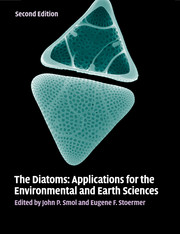Book contents
- Frontmatter
- Contents
- List of contributors
- Preface
- Part I Introduction
- Part II Diatoms as indicators of environmental change in flowing waters and lakes
- Part III Diatoms as indicators in Arctic, Antarctic, and alpine lacustrine environments
- Part IV Diatoms as indicators in marine and estuarine environments
- Part V Other applications
- 24 Diatoms of aerial habitats
- 25 Diatoms as indicators of environmental change in wetlands and peatlands
- 26 Tracking fish, seabirds, and wildlife population dynamics with diatoms and other limnological indicators
- 27 Diatoms and archeology
- 28 Diatoms in oil and gas exploration
- 29 Forensic science and diatoms
- 30 Toxic marine diatoms
- 31 Diatoms as markers of atmospheric transport
- 32 Diatoms as non-native species
- 33 Diatomite
- 34 Stable isotopes from diatom silica
- 35 Diatoms and nanotechnology: early history and imagined future as seen through patents
- Part VI Conclusions
- Glossary, acronyms, and abbreviations
- Index
- References
32 - Diatoms as non-native species
from Part V - Other applications
Published online by Cambridge University Press: 05 June 2012
- Frontmatter
- Contents
- List of contributors
- Preface
- Part I Introduction
- Part II Diatoms as indicators of environmental change in flowing waters and lakes
- Part III Diatoms as indicators in Arctic, Antarctic, and alpine lacustrine environments
- Part IV Diatoms as indicators in marine and estuarine environments
- Part V Other applications
- 24 Diatoms of aerial habitats
- 25 Diatoms as indicators of environmental change in wetlands and peatlands
- 26 Tracking fish, seabirds, and wildlife population dynamics with diatoms and other limnological indicators
- 27 Diatoms and archeology
- 28 Diatoms in oil and gas exploration
- 29 Forensic science and diatoms
- 30 Toxic marine diatoms
- 31 Diatoms as markers of atmospheric transport
- 32 Diatoms as non-native species
- 33 Diatomite
- 34 Stable isotopes from diatom silica
- 35 Diatoms and nanotechnology: early history and imagined future as seen through patents
- Part VI Conclusions
- Glossary, acronyms, and abbreviations
- Index
- References
Summary
Introduction
The degree to which diatoms move across the Earth by natural processes is debatable (Finlay et al., 2002; Vyverman et al., 2007), but the inadvertent spread of diatoms in a globalized human society is apparent. In this chapter, we examine documentation of diatom introductions and their implications for aquatic ecosystems. For many organisms, especially larger ones, the ecologic, economic, and social impact of species introductions, or invasions, is relatively well known (Pimental et al., 2000). On the other hand, recognition of the microscopic trespasses of diatom species and their impact on ecosystems in new geographic areas is generally far less noticed.
A species is considered to be “non-native” if it is located in a region outside of its native geographic range. Non-native species are also referred to as introduced, non-indigenous, exotic, alien, or invasive. While some non-native species cause little harm, others cause severe ecosystem damage. The use of terminology, particularly the adoption of military words to describe species geographic distributions, elicits emotional reactions that influence scientific and popular responses (Larson et al., 2005). We recognize that much of the current literature employs these military metaphors, but we seek to promote an ecological perspective.
Even among well-known organisms, such as the common reed (Phragmites australis (Cav.) Trin. ex Steud.) growing near Lake Superior, the distinction between native and non-native status may be unclear (Willis and Birks, 2006). The biogeographic distribution of diatoms, and microscopic organisms in general, is currently under debate.
- Type
- Chapter
- Information
- The DiatomsApplications for the Environmental and Earth Sciences, pp. 560 - 569Publisher: Cambridge University PressPrint publication year: 2010
References
- 16
- Cited by



